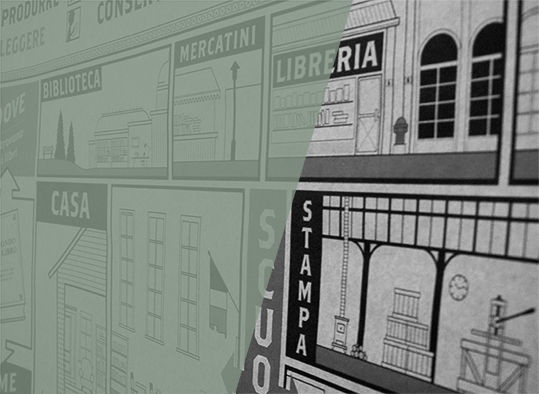Triennale, Milano; Palazzo Forti, Verona; Ex Cotonificio, Seregno; Spazio Cultura Sesto San Giovanni; Galleria Accursio, Bologna; Villa Bozzolo, Casalzuigno; 2002 – 2010, con Fondazione Mondadori, ABCittà, AIB, AIE, ANARPE
Triennale, Milano; Palazzo Forti, Verona; Ex Cotonificio, Seregno; Spazio Cultura Sesto San Giovanni; Galleria Accursio, Bologna; Villa Bozzolo, Casalzuigno; 2002 – 2010, with Fondazione Mondadori, ABCittà, AIB, AIE, ANARPE
Lo scambio di informazioni, così come la lettura e la scrittura hanno subito grandi trasformazioni nel tempo. Negli ultimi anni, inoltre, il sopravvento dell’informatica ha portato sostanziali modifiche nel mondo del libro e nei diversi supporti. Questi cambiamenti secondo alcuni avrebbero indebolito l’oggetto libro quale strumento del sapere e della comunicazione, e soprattutto starebbero lentamente minando la sua collocazione storica, sociale e culturale. Bisogna riscoprire le valenze e le potenzialità del libro. La storia del libro ha una lunga tradizione, sia in Italia che all’Estero, ma da qualche anno anche nel nostro paese cresce l’interesse per lo studio del libro rispetto alla genesi, alla composizione materiale e alla conoscenza dei mestieri e delle prassi artigianali e industriali ad esso legati. Ora occorre inserirsi nel “tempo dei computer” per avviare una rapida connessione capace non solo di preservare e individuare le tracce di una parte assai rilevante della storia culturale, che lentamente svanisce nei ricordi, ma soprattutto di tenere viva e alimentare una tradizione lavorativa a rischio di estinzione. Bisogna infine operare affinché bambini e famiglie riprendano confidenza con i luoghi pubblici del sapere: biblioteche e librerie, devono tornare ad essere ambienti intimi e amichevoli, i libri devono essere ricollocati nel cuore della casa, come segno tangibile della loro presenza. All’interno di tali presupposti si è mosso il progetto, concepito come mostra/laboratorio rivolto a bambini di età compresa tra gli 8 e gli 11 anni. L’intento era quello di familiarizzare i bambini e i ragazzi con il libro, con il suo processo produttivo, con il suo uso e con le relative sensazioni che è in grado di suscitare. Il libro, compagno di vita, amico insostituibile, e come citava il sottotitolo, oggetto da usare, da produrre, da leggere, da maneggiare, da scambiare e da conservare. In sei anni, sette edizioni in tre regioni con oltre diecimila visitatori.
As time passes, the exchange of information, reading and writing have undergone great transformations. Moreover, in recent years the prevailing of information technology has brought substantial changes to the world of books and other media. In the opinion of some, these changes have weakened the book as a tool of knowledge and communication and are slowly undermining its historical, social, and cultural position. The values and potentialities of books need to be rediscovered. The history of the book has a long tradition in Italy and abroad, and over the last few years in Italy, the interest in books has grown as far as their genesis, material, craftsmanship, handmade and industrial processes are concerned. Now it is time to integrate this with our ‘computer era’, creating a rapid connection which is capable not only of preserving and identifying the traces of a very important part of our cultural history – which is slowly vanishing in our memories – but also keeping alive and feeding an industry which is facing extinction. Finally, children and families must get to know the public places of knowledge: libraries and bookshops should once again become intimate and friendly environments, and books should return to the heart of our homes, as a tangible sign of their presence. Such were the purposes of this project, conceived as an exhibition/workshop for children aged 8-11. The aim was to let children get to know books, their production process, their use and the sensations they can arouse. The book is a life companion, an irreplaceable friend, and as the sub-header notes, an object to use, produce, read, handle, exchange, and preserve. Over six years, with seven editions which have taken place in three regions, over ten-thousand people have attended this exhibition.



